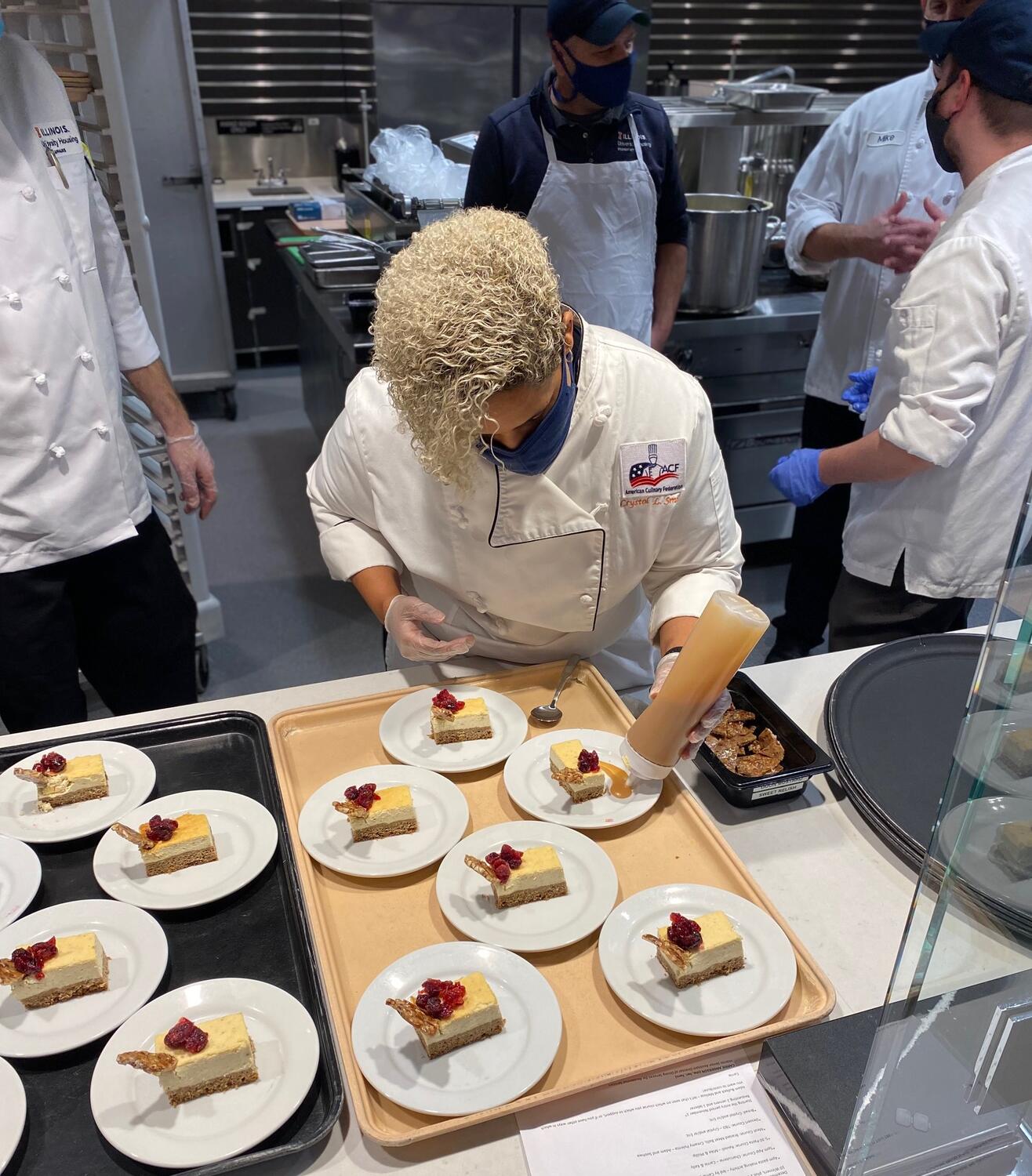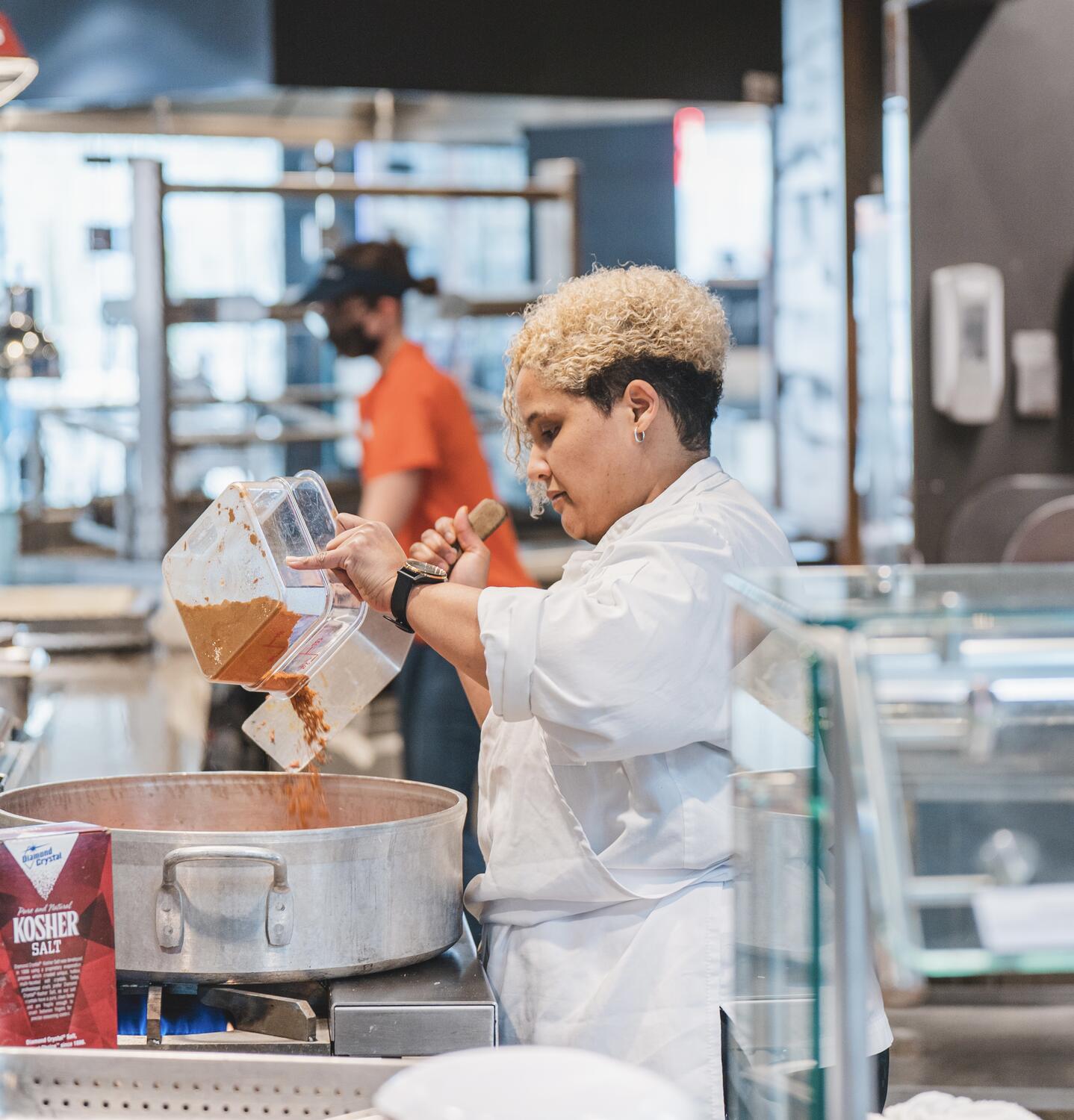
Chef Crystol Brings a Slice of Home to University Housing
When Crystol Smith was sitting in a classroom studying psychology at Michigan State University, just two semesters away from graduation, she couldn’t have imagined one day being a head chef in one of the dining halls at the University of Illinois.
Her path to Dining Services, a part of University Housing, took several years and a number of winding turns, but it all began with a realization.
“I was going to school for psychology, and I just said, ‘I don’t want to do this,’” Smith said.
Over time, she kept returning to one thought: She loved being in the kitchen.
“I knew I wanted to cook. I was very comfortable in the kitchen … it felt very calm. It’s a lot of chaos, but it’s very peaceful,” Smith said.
After leaving Michigan State, Smith went to community college and earned her associate’s degree in restaurant management and food services and began working in the food service industry.
But she hadn’t yet found her niche.
No Half-Baked Ideas: Art Meets Science
Growing up in Michigan, in a suburb of Detroit, Smith watched a lot of cooking shows on PBS. She remembers when the Food Network was just taking off, and she found it inspiring. She particularly connected with host Alton Brown, who incorporated a lot of the science of cooking in his show, which pointed her in the right direction.
“I chose pastry because I really love science, and I really love art, and the two are one together,” Smith said. “There’s a lot of science in baking and pastry.”
Smith enrolled at the Culinary Institute of America in Hyde Park, New York, and became a pastry chef.
Even as her career focus began to take shape, Smith’s ultimate landing spot was a few steps away.
Her fiancé’s job led Smith to the Champaign-Urbana area, where she worked at Pekara Bake House, now known as Central Illinois Bake House. She made bread there and said it was “great; it was fun because I love bread,” but she was eager to learn and do more.
One day a chef at the bake house handed Smith an application to be a pastry chef in catering at the University of Illinois, and she decided to give it a shot.
“I didn’t know what to expect … I wanted to be a pastry chef; I went to school to be a pastry chef – it’s what I want to do. That’s what the job was, so I was excited about that,” Smith said.

Since coming here in 2014, it’s turned out well, for both Smith and the students she now serves.
A Generation of Foodies: Cooking for the College Crowd
While Smith never pictured herself working in dining at a university and didn’t know what to expect, she’s not alone in discovering the surprising upsides to this opportunity.
Carrie Anderson, the senior assistant director for Dining Services, said what makes working in dining at a university special is the primary dining audience: students.
Smith echoed that sentiment, saying she enjoys talking to students and “learning about where they’re from and what they want to see on the menu – that’s the best part of Housing.”
She said the students here are very into current food trends, and Anderson agreed.
“Our audience is very much in tune to food. Foodies at heart,” Anderson said. “It’s very much part of their existence. The generations we are currently serving and have served, specifically right now, everyone is a foodie. So it may seem from the outside looking in like we’re just mass producing food, but there’s a lot of joy and excitement and innovation we have.”
They both attribute students’ “foodie” instincts in some way to social media.
“Everyone in this demographic has social media … or what seems like everyone,” Smith said. “And they’re always taking pictures, and so they’re driving what others are seeing. Because we’re in college dining, these are the young people who are going out into the world to make changes. What they want is what we want to provide them.”
Smith said today’s students think about the environment and climate change and that impacts their perspective on food. She noted that “plant-forward, plant-based cooking is becoming very mainstream,” and she and the team around her get to be creative with how they incorporate that into daily menus.
... the Dining Services team believes an important aspect of these themed meals and special dining events is to help students “learn about the different cultures of people who all share this as their home.”
Today’s college students are also increasingly culturally aware and eager to try new things.
One of the ways the Dining Services team satisfies that curiosity is through special themed meals and dining events. These include menus with cultural themes, often scheduled to help the university’s diverse student body feel at home and to honor the holidays and traditions celebrated by students who come to Champaign-Urbana from all over the world.
“For people of those cultures, it makes them feel really welcomed and at home and comforted if they’re away from home or very far from their families,” said Kelly Boeger, a licensed dietitian who, through her role as University Housing’s assistant director of dining for menu management, works closely with Smith.
“We do get feedback from students saying [things] like, ‘That certain dish was exactly like my mom’s. Thank you so much for making it,’” Boeger said. “Or, ‘Can you serve shepherd’s pie again? It reminds me of being back home, and I miss it.’”
Smith referenced a student who thanked the chefs for often serving congee on Sundays. She said the student had been “homesick, so when they had it, it brought them some comfort.”
She’s also received feedback from students who were excited about and appreciated the chance to try new things for the first time.
Boeger said the Dining Services team believes an important aspect of these themed meals and special dining events is to help students “learn about the different cultures of people who all share this as their home.”
Boeger and Smith said Dining Services regularly partners with the cultural houses on campus, who help provide an educational component to the themed menus and dining events.
“[Students] come for the food and stay for the talk; that’s what you hope,” Smith said.
A Rising Star: Praise, Promotions and Psychology
After Smith began working with University Housing as a pastry chef in catering, she gained experience in other positions with Dining Services before becoming head chef at the Illinois Street Residence Dining Center.
Anderson said Smith’s unique background has allowed her to excel at the university, starting with her experience with pastry.
“She also has a very unique skillset with regard to Top 9 [allergen-free] food preparation, both pastry and savory,” Anderson said. “And she also has a very strong science and chemistry background and understanding of how that applies to food. She’s quite innovative as well.”
In her role as a head chef, Smith has a variety of duties that go far beyond hands-on food preparation. She’s involved with menu planning; budgeting; hiring; employee and customer relations; the training of new and current staff, such as educating them on various spices and techniques; recipe testing; and administrative work related to all of the above.

She works with a large team of people, including Boeger and Anderson.
Boeger recalled Smith practicing for a National Association of College and University Food Service competition and getting to try some of the dishes she was making from scratch, which she described as being “so delicious.”
“I was just really impressed with how creative she was with everything, and then her organizational skills as well were really impressive,” Boeger said. “And she brings that to the dining hall as well. She does that every day at ISR.”
Smith, Boeger and Anderson all contributed creative ideas to University Housing’s recent renovation of the ISR Dining Center, which now features eight all-you-care-to-eat micro restaurants, an instructional kitchen and retail spaces.
“We have been very intentional about making sure our dining rooms are an extension of where the students live but also representative of where they come from,” Anderson said. “It does really allow us to connect with as many students as possible from across the globe through food. If you can see yourself represented anywhere you go … if you see parts of yourself there, you feel comfortable; you feel seen; you feel valued.”
Smith recently earned her bachelor’s degree, which included a minor in her old field of study, psychology. Anderson said one of Smith’s greatest attributes is that she makes the staff around her also feel seen and valued and thinks her background in psychology may have helped with that.
“She also cares deeply about people and their experience, their varied social identities and how their social identities impact how they show up at work, how they do their job, how they leave the job at the end of the day, and I think she’s just extremely in tune to people,” Anderson said.
She noted how one employee has made a point to repeatedly tell high-level administrators how much they love their job and are proud to be part of the Dining Services team, specifically praising how Smith makes them feel “seen” and that their work is valued.
Food for Thought: Making Memories
While the team around Smith sees her many star qualities, she’s not looking for praise or even basic thank-yous.
“I’m a back-of-the-house person,” she said. “I don’t want to be the show; I don’t want to be the person up front; I just want to be a part of the memory, but you don’t know that I’m a part of it.”
Smith believes food plays a big part in people’s memories, saying, “You don’t always remember the event, but there’s usually a food or dish you do remember that was good or bad. You remember the food.”
Her own food memories help tell her life story and have likely played a role in shaping her career.
She remembers her mom asking what she wanted for her birthday dinner each year. It was usually steak, crab legs or lasagna, Smith said.
“I have memories of my mom’s lasagna, and my wife has memories of her mom’s lasagna,” Smith said with a smile. She and her wife now go back and forth about how to make “real lasagna,” as each believes the way their mom made it is how lasagna should taste.
In fact, many of Smith’s food-related memories make her think about family. She remembers being just 4 or 5 years old and in the kitchen with her grandma when she made chicken soup. She laughs at memories of the day her father made her sit at the table until she finished liver and onions and the times her step-mother made yellow cake and feared “the cake would fall in” if the kids yelled or slammed doors while it was baking.
For Smith and her family, new food memories are always being made. She asks each family member what one dish they’d like for Christmas so their holiday meals are fun and special. She thinks her own daughter will likely grow up with “sensory memories” of her making lasagna and her wife making cottage pie.
Likewise, Smith is conscious of the fact that University of Illinois students are likely to have food-related memories from their time in University Housing. While the students here are not her family members, she approaches her work as if they are.
“This is their home; we’re their extended family, and we have to take care of them. They need comfort also.”